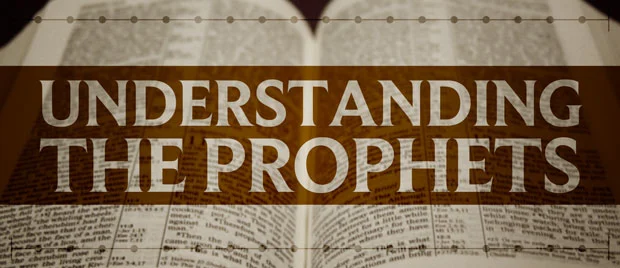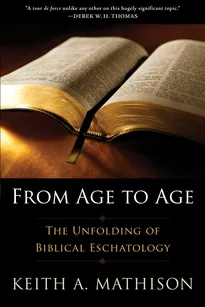Understanding the Prophets

What is a Prophet?
The interpretation of the prophetic books is not a simple matter, and in order to understand these books, they must be approached with care and caution.1 They cannot be approached as if they were little more than collections of arcane predictions. As we shall discover, they are much more than this, but before proceeding to an examination of the individual prophetic books, we must answer some preliminary questions. First, what is a prophet? In the Old Testament, the word used most frequently to refer to a prophet is nabi'. The general meaning of the word is "spokesman." In the Old Testament, a prophet "was a spokesman for God with the distinct call to be the ambassador of God."2 In fact, it was the call of God that gave the true prophet his legitimacy.3 Other titles used to describe prophets are ro'eh, meaning "seer;" hozeh, also meaning "seer;" and 'ish-ha'elohim, meaning "man of God." Pieter Verhoef explains, "These titles together define the prophet as a man who has been called to communicate the revealed word of God, a man who has an intimate relationship with God as his servant and messenger, and as one whose task it is to keep watch over God's people."4
According to Scripture, the prophetic office originated with Moses in the events at Mount Sinai (Deut. 18:15–16; cf. Hos. 12:13). The office of the prophet, then, is directly associated with the Sinai covenant.5 After the exodus from Egypt, Moses had led the people of Israel to the mountain. Upon their arrival, Moses ascended the mountain, and it was revealed to him that God would descend in a thick cloud in order that the people might hear and believe that which he would speak to Moses (Ex. 19:9). On the morning of the third day God descended on the mountain in smoke and fire (vv. 16–20). There he gave the Ten Commandments (Ex. 20:1–17). In fear, the people then said to Moses, "You speak to us, and we will listen; but do not let God speak to us, lest we die" (v. 19). The people asked Moses to be a mediator of God's word. All of the prophets who followed Moses shared this role.6
The Context of the Prophets
A second important issue that must be raised is the broad historical context of the prophetic books. The ministries of all of the writing prophets can be dated from the eighth to the fifth centuries BC.7 The books of 2 Kings, Ezra, and Nehemiah, therefore, provide the redemptive-historical context for these prophets. It will be recalled that these historical books recount the events leading to the exile, the exile itself, and the early stages of restoration after the exile. As Robertson explains, " . . . the writings of Israel's prophets eventually must be seen as centering primarily around two events of immeasurable significance: Israel's exile and restoration."8 The redemptive-historical context of the writing prophets, then, is "the death and resurrection of Israel" (cf. Ezek. 37:1–14).9
The Language of the Prophets
In addition to understanding the historical context of the prophetic books, it is also necessary to understand the nature of the language they used. Although other genres are found in the prophetic books, including biographical and autobiographical narrative, the most common form of prophetic speech found in these books is the oracle.10 The term "oracle," as John Sawyer observes, "is applied to all manner of prophetic utterances from lengthy 'oracles concerning foreign nations' (e.g. Isa. 13:1; 14:28; 15:1; 17:1; 19:1; 21:1; 23:1) and whole books (e.g. Nahum, Habakkuk, Malachi) to shorter prophecies addressed to specific situations (e.g. Ezek. 12:10)."11 The prophetic oracles may be distinguished according to their content as either oracles of judgment or oracles of salvation.12
The prophetic oracles tend to employ poetic language rather than prose.13 This is significant because Hebrew poetry is a highly stylized form of literature. It is characterized largely by its extensive use of figurative language and striking imagery. Hebrew poetry uses numerous metaphors and other figures of speech. When it is understood that the biblical prophets make extensive use of poetic language, it becomes evident that those parts of the prophetic books that are poetic in nature are not to be interpreted in the same manner that prose is interpreted.
The Prophetic Message
A final topic that must be examined before proceeding to the individual books of the prophets concerns the nature of the prophetic message. Undergirding the message of all the prophets is their understanding of the law and the covenant. The blessings and curses of the Mosaic covenant found in texts such as Leviticus 26 and Deuteronomy 28 are the foundation for the prophets' messages of judgment and restoration.14 As Douglas Stuart explains, "Nearly all of the content of the classical (writing) prophets' oracles revolve around the announcement of the near-time fulfillment of covenantal curses and the end-time fulfillment of covenantal restoration blessings."15 O. Palmer Robertson observes how the connection between the Abrahamic and Mosaic covenants explains some of the apparent paradoxes in the prophetic message.
The binding together of these two covenants explains how the prophets of Israel could anticipate both disaster and blessing for Israel. Disaster must come because of violation of covenant law. But blessing can be promised as the final end because of the sovereign commitment on the part of God to bless his people despite their deserving nothing.16
The Davidic covenant also provides a foundation for the message of the prophets. God's promise in this covenant to preserve a descendant of David on the throne and to defend Jerusalem "provides the strongest basis for hope in a future messianic king beyond the judgment of exile . . . "17
Oracles of Judgment
The basic message of the prophets included both oracles of judgment and oracles of salvation. In the oracles of judgment, the prophets condemned Israel for violating the covenant law and declared the imposition of the covenant curses.18 Many of the oracles of judgment take the form of a prophetic lawsuit at the end of which God pronounces his sentence on Israel (cf. Jer. 2:5–9; Hos. 2:4–25; 4:1–3; Mic. 6:1–8).19 Exile was the ultimate judgment because it was, in effect, a death sentence for Israel.20 A significant part of the prophetic message of judgment was the proclamation of the coming "Day of Yahweh" or "Day of the Lord." In the prophets, the Day of Yahweh is a complex idea that encompasses both judgment and salvation. This concept is best examined in the context of its usage in the individual prophetic books of Scripture in which it is found.
There is some controversy regarding the purpose of the oracles of judgment. Were they intended to produce repentance and avoid judgment, or were they intended to be understood as predictions of unavoidable judgment? Using the terminology of speech-act theory, Walter Houston asks whether these oracles are "calls for repentance (which would fall into the category of directive acts), or announcements of coming doom (which would presumably be assertive)?"21 O. Palmer Robertson rightly concludes that these oracles were intended to lead to repentance and to avert the prophesied judgment (cf. Jer. 26:2–3).22 As he explains, the prophetic word "does not primarily involve prediction regarding future events."23
Oracles of Salvation
In addition to oracles of judgment, the basic message of the prophets also includes oracles of salvation. These oracles proclaim the coming of a new era following judgment. Like the oracles of judgment, the oracles of salvation are also rooted in the covenants (cf. Lev. 26:40–45; Deut. 4:30–31; 30:1–10). John Bright observes the significance of these messages of restoration.
Virtually all of the pre-exilic prophets, albeit by no means in identical ways, looked beyond the judgment they were compelled to announce to a farther future when God would come once again to his people in mercy, restore their fortunes, and establish his rule over them in righteousness and peace. This promise of future salvation is one of the most distinctive features in the message of the prophets, and it is this perhaps more than anything else that serves to bind the Old Testament unbreakably with the New in a single canon of Scripture.24
The pre-exilic prophets looked forward to the restoration of Israel following the exile. As we shall discover, however, the post-exilic prophets view the return from exile as only the beginning of the eschatological restoration.
The Kingdom of God
One of the most significant elements found in the prophetic message of salvation is the establishment of God's kingdom through a descendant of David, a Messiah.25 The roots of the messianic idea are found in several texts in the Pentateuch (Gen. 17:6, 16; 35:11; 49:10; Num. 24:17; Deut. 17:14–20).26 The primary foundation of this concept, however, rests in the covenant God made with David (2 Sam. 7). According to the prophets, the coming Messiah will establish God's kingdom, transforming creation and bringing blessing to all the nations, thereby fulfilling the purpose of God's covenant with Abraham (cf. Gen. 12:3; Ps. 72:17).27
Creation
The transformation of creation associated with the coming of the Kingdom of God ties together God's creational purposes and his redemptive purposes. According to the prophets, "there is no redemption unless it affects the whole of creation."28 The prophets recognize that there is something radically wrong in the present creation, but unlike the followers of many pagan religions, they do not assert that the physical world is itself inherently evil. The present corruption of God's creation is due to sin. The prophets, therefore, affirm that all of creation will be transformed and what is wrong will be set right in the eschatological victory over evil.29
This article is part of the The Unfolding of Biblical Eschatology collection.
-
For a helpful introduction to the subject, see Willem VanGemeren, Interpreting the Prophetic Word (Grand Rapids: Zondervan, 1990); O. Palmer Robertson, The Christ of the Prophets (Phillipsburg: P&R, 2004). ↩
-
Van Gemeren, Interpreting the Prophetic Word, 42 (emphasis in original); cf. also John F. A. Sawyer, Prophecy and the Biblical Prophets, rev. ed. (New York: Oxford University Press, 1993), 1. ↩
-
For a complete discussion of the divine call and commissioning of the prophet, see Robertson, The Christ of the Prophets, 67–90. ↩
-
NIDOTTE, 4:1068; cf. also Robertson, The Christ of the Prophets, 2004, 23; Edward J. Young, My Servants the Prophets (Grand Rapids: Eerdmans, 1952), 13. ↩
-
Cf. William Dumbrell, Covenant and Creation (Nashville: Thomas Nelson, 1984), 136–37. ↩
-
Robertson, The Christ of the Prophets, 2004, 25. Moses was unique in being the mediator of God's covenant. All of the prophets were mediators of God's word. ↩
-
Hans Walter Wolff, "Prophecy from the Eighth Through the Fifth Century" in Interpreting the Prophets, ed. James Luther Mays and Paul J. Achtemeier (Philidelphia: Fortress, 1987), 15. ↩
-
Robertson, The Christ of the Prophets, 2004, 195; cf. 453–98. ↩
-
Donald E. Gowan, Theology of the Prophetic Books (Louisville: Westminster, 1998), 9. ↩
-
C. Hassell Bullock, An Introduction to the Old Testament Prophetic Books, rev. (Chicago: Moody, 1986), 29. ↩
-
Sawyer, Prophecy and Biblical Prophets, 28. ↩
-
VanGemeren, Interpreting the Prophetic Word, 78. ↩
-
Bullock, Introduction, 1986, 31; Dan McCartney and Charles Clayton, Let the Reader Understand (Wheaton, IL: Victor, 1994), 217. ↩
-
Robertson, The Christ of the Prophets, 122. As Dumbrell (Covenant and Creation, 138) explains, the covenant office of prophet was needed "because of Israel's potential infidelity." ↩
-
Douglas Stuart, Hosea–Jonah, WBC 31 (Nashville: Nelson, 1987), xxxii. ↩
-
Robertson, The Christ of the Prophets, 2004, 178. ↩
-
Robertson, The Christ of the Prophets, 180–81. ↩
-
VanGemeren, Interpreting the Prophetic Word, 78–9. ↩
-
For a helpful explanation of the prophetic lawsuit, see VanGemeren, Interpreting the Prophetic Word, 400–407. ↩
-
Gerhard von Rad, The Message of the Prophets, trans. D. M. G. Stalker (New York: Harper & Row, 1967), 12. ↩
-
Walter Houston, "What Did the Prophets Think They Were Doing? Speech Acts and Prophetic Discourse in the Old Testament" in The Place Is Too Small For Us: The Israelite Prophets in Recent Scholarship, ed. Robert P. Gordon (Winona Lake, IN: Eisenbrauns, 1995), 145. ↩
-
Robertson, The Christ of the Prophets, 94. ↩
-
Robertson, The Christ of the Prophets, 26; cf. pp. 407–51. ↩
-
John Bright, Covenant and Promise (Philadelphia: Westminster, 1976), 15; cf. also VanGemeren, Interpreting the Prophetic Word, 89. ↩
-
VanGemeren, Interpreting the Prophetic Word. ↩
-
Daniel Block, "My Servant David: Ancient Israel's Vision of the Messiah" in Israel's Messiah in the Bible and the Dead Sea Scrolls, ed. Richard S. Hess (Grand Rapids: Baker Academic: 2003), 37. ↩
-
VanGemeren, Interpreting the Prophetic Word, 233. ↩
-
VanGemeren, Interpreting the Prophetic Word, 86. ↩
-
Donald E. Gowan, Eschatology in the Old Testament, 2d ed. (Edinburgh: T&T Clark, 2000), 2. ↩



